


The comparative analysis of the cost structure of marine capture fisheries of the countries studied between 1995 and 1997 focussed on the analysis of differences in the operating cost structure of two types of fisheries i.e. industrial and medium-scale trawl fisheries and small-scale fisheries in developed and developing countries.11
Among the more outstanding findings were that in the case of trawl fisheries, there are significant differences in the cost structure between developed and developing countries, which are related to the higher cost of labour in the former countries. In the trawl fisheries of developed countries, labour costs were the most important element followed by running costs and vessel costs while in developing countries, labour costs were less important and running costs were the most important cost element. For the same reason i.e. higher labour costs, the operating costs per unit of gross earnings were higher for trawlers in developing countries than for trawlers in developed countries.
The operating cost structure of small-scale fisheries showed some differences from the one of industrial trawl fisheries, which depended, however on the fact, whether the country were the fishing vessels operated was a developed or a developing one. In the developed countries, labour cost remained the most important cost element. Vessel costs became the second most important cost element and running costs become the least important cost element because of the lower fuel expenses. In the developing countries, however, labour costs become now the most important element of operating costs (as it was the case in the developed countries, both in case of industrial trawl fisheries and in small-scale fisheries) because of the fact that a sharing system of remuneration rather than a fixed wage system is used. For the same reason i.e. the higher importance of labour costs in small-scale fisheries in developing countries, the differences in operating costs per unit of gross earnings, which could be observed in the case of industrial trawl fisheries could not any longer be observed in the case of small-scale fisheries.
In the following chapter, three different categories of vessels are compared regarding their cost structure i. e. deep sea trawlers, small-scale fishing vessels and tuna vessels. They have been selected as they are among the economically most important vessels in terms of common use, quantity and value of catch and generation of employment. For each category of fishing vessel, first the operating costs are analysed consisting of running costs, labour costs and vessel costs and then the total costs, which also include the cost of depreciation and interest i.e. the costs of the capital invested in the fishing vessel.
The findings of the country studies carried out recently validate and confirm the information generated by the studies carried out between 1995 and 1997 and do not indicate any major changes in the structure of the cost of operations. As illustrated in Figure 1 below, the cost of labour has remained the most important cost component of the deep sea trawl fisheries in the developed countries studied i.e. the European countries France, Norway, Germany and Spain. According to the recently collected data, the cost of labour accounts for 38% to 60% of the cost of operations. The second most important cost com-ponent of most European deep-sea trawlers is running costs closely followed by vessel costs.12
FIGURE 1
Operating costs of deep-sea trawlers in Europe
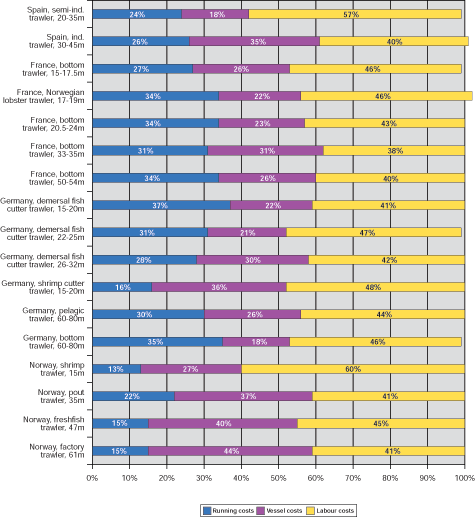
The six types of trawlers where vessel costs are higher than running costs include all types of Norwegian vessels i.e. shrimp trawlers, factory trawlers, pout trawlers and freshfish trawlers as well as German shrimp trawlers and large German demersal fish cutter trawlers.
In the South American countries Argentina and Peru and in the Caribbean country of Trinidad and Tobago, which have a lower level of economic development than the European countries studied and subsequently a lower level of remuneration of labour, the labour costs in trawl fisheries are lower than in the European countries and account for only between 34% and 40% of total operating costs in Argentina and Peru and for as little as 11% in Trinidad as shown in figure 2 below. Different from deep sea trawlers of European countries, running costs are the most important cost component and account for between 40% and 62% of the total operating costs of deep sea trawlers in Argentina and Peru.
When comparing the two South American countries i.e. Peru and Argentina, the comparatively low vessel costs in Peru because of low expenditure for repair and maintenance are interesting to note as well as the comparatively high running costs of trawlers in Peru, where fuel costs account for up to 55% of total operating costs and up to 47% of total earnings.13
In Trinidad and Tobago like in other developing countries, running costs are the most important element of the operating costs with 58% and vessel costs are the second important cost component of the operating costs with 31%.
The same trend as in the case of Trinidad and Tobago, Argentina and Peru can be observed regarding trawlers in the developing countries studied in South, South East and East Asia i.e. India, Thailand and the Peoples Republic of China. Figure 3 below shows that with the exception of two types of Chinese vessels, labour costs only amount to somewhere between 16% and 30% of the operating costs of deep-sea trawlers while running costs are the most important cost component and among the running costs, the cost of fuel is highest. Generally, vessel costs are of minor importance, in most cases accounting for less than 20%.
Two of the three types of Chinese vessels show a little different picture i.e. the pair trawlers and the stow netters, while the results of the 26 m deep sea trawlers correspond to a large extent to the situation in Thailand and India. The 30.5 m steel hull stow netters14 show an extremely high share of vessel costs (they account for 64% of total operating costs) because of very high expenditure for the particular type of fishing gear operated by the vessels i.e. stow nets and its repair and maintenance (see ANNEX I). The operations of the 25 to 28 m pair trawlers are very labour-intensive with labour costs accounting for 43% of total operating costs. This is directly related to the larger crew required for pair trawling operations.
FIGURE 2
Operating costs of deep-sea trawlers in South America and the Caribbean
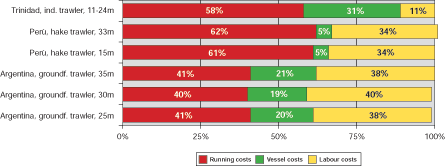
FIGURE 3
Operating costs of trawlers and stow netters in Asia
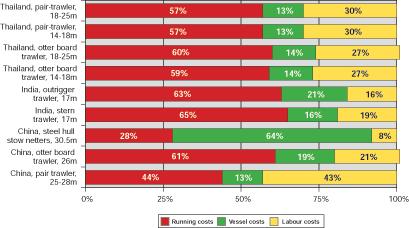
When taking into consideration the costs of operation, which lead to the gross cash flow, vessel costs only include expenses for repair, maintenance, etc., but no costs of investment (depreciation and interest), which are closely related to the value of the vessel active in a particular fishery. If these cost components, which are only calculated and not part of the actual cash flow are also considered, a different picture is shown in some cases with regard to the ranking of cost components as shown in figure 4 below.
FIGURE 4
Total costs of deep-sea trawlers - EUROPE
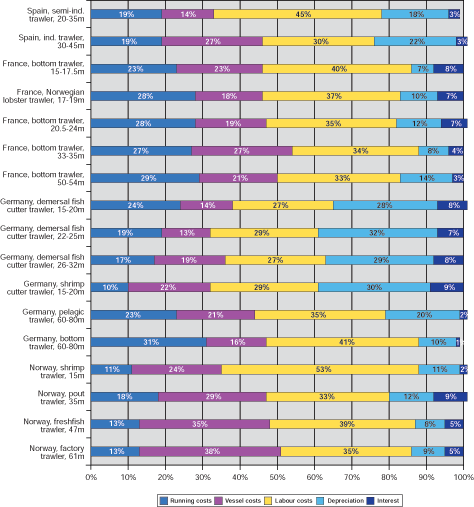
In the majority of fleet segments studied in Norway, Germany, France and Spain, vessel costs, together with depreciation and interest, become the most important cost component followed by labour costs. This trend is more pronounced in Norway and Germany than in France and Spain.
It is interesting to note that costs of depreciation and interest are particularly high in Germany and here again particularly high in the case of the four types of cutter trawlers, which have been included in the study. The reason for the high costs of depreciation is the high costs of fishing vessel construction in Germany as the cost of depreciation directly depends on the replacement costs. The high cost of interest is related to the relatively high actual value of the German cutter trawler fleet as the vessels are comparatively old but have recently been updated and refitted with new equipment.
As already in the case of operating costs, a different picture emerges for the developing countries studied South America and the Caribbean countries i.e. Argentina, Peru and Trinidad. As shown in figure 5 below, vessel costs continue to play a minor role even when taking into account all costs of investment i.e. the cost of depreciation and the cost of interest. Running costs remain the major cost component of total costs, followed by labour costs.
The reason for the differences in the total cost structure between trawlers in developed European countries and developing countries of South America and the Caribbean is that the cost of fishing vessel construction and thus the cost of vessel replacement and depreciation are lower in developing countries, among other things, because of the lower cost of labour. The cost of interest is also lower in some cases as fishing vessels in developing countries are generally older and in many cases the actual value of many vessels is negligible as the vessels have already been fully written off.
The trend observed above is even more pronounced when looking at the total cost structure of deep-sea trawlers in developing countries of Asia shown in figure 6 above. Running costs remain the most important single cost element even when compared to vessel costs, depreciation and the cost of interest combined. The only exception is the 25 -28 m pair trawlers in China where vessel costs combined with depreciation and interest become slightly more important than running costs. This is the case because of the higher cost of investment in pair trawling as compared to single boat trawling and to the related higher actual values and replacement costs of the vessels involved in the fishing operation.
FIGURE 5
Total costs of deep-sea trawlers in South America and the Caribbean

FIGURE 6
Total costs of deep-sea trawlers - ASIA

In this section, the cost structure of small-scale fishing vessels with a length up to 12 meter operating various types of fishing gear is compared. Similarly, as in the comparison of the fleet segments of trawl fisheries, the different cost components are related to the operating costs as well as to the total costs, which include deprecia-tion and interest.
As shown in figure 7 below and as it has also been the case in the European deep sea trawl fisheries, labour costs - amounting from 45 to 64% - account for the major share of operating costs in the European small-scale fisheries studied i.e. in Norway, Germany and France. Vessel costs are the second highest cost component ranging from 20 to 35%. Running costs ranging from 7% to 20%, except for German coastal vessels, play a minor role mainly caused by lower fuel expenses. The importance of labour costs compared to vessel costs and running costs, is even higher than in deep-sea trawl fisheries.
When adding the costs of investment i.e. depreciation and interest to vessel costs, vessel costs gain considerable importance as shown in figure 8 below. Vessel costs and depreciation and interest combined range from 23% to 51% of the total costs.
FIGURE 7
Operating costs of small-scale fishing vessels - EUROPE
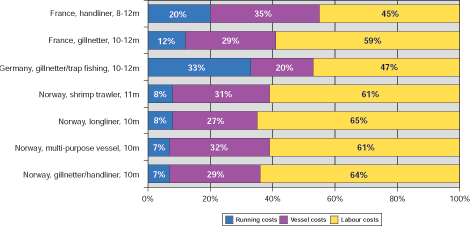
FIGURE 8
Total costs of small-scale fishing vessels - EUROPE

This finding shows that European small-scale fisheries are relatively capital intensive and that capital is substituting expensive labour. This trend is more pronounced in the case of the German and French vessels and less pronounced in the case of the Norwegian vessels.
Compared to the European small-scale fishing vessel, the cost structure of Senegalese small-scale fishing vessels shows some differences as shown in figure 9 below. While, as in the case of European countries, labour costs are the most important cost element of the operating costs, their share is significantly higher than in the developed European countries included in the study. This supports the earlier finding that small-scale fisheries in developing countries is more labour intensive than in developed countries. Different from the European countries studied, vessel costs is the least important element of operating costs due to low costs of vessel maintenance and repair.
When considering the cost of depreciation and interest, these costs are less important in Senegal - a developing country - compared to the European countries as less capital is combined with the cost of depreciation and interest only range between 7% (in case of the handliner) and 21% (in case of two canoe purse seining) of the total costs. In the case of the European vessels studied, the range was much higher i.e. 23% to 51%.
FIGURE 9
Operatings costs of small-scale fishing vessels - SENEGAL
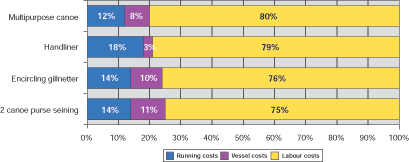
FIGURE 10
Total costs of small-scale fishing vessels-SENEGAL
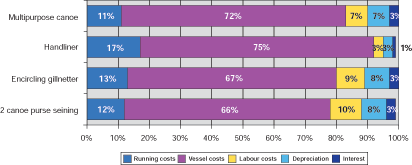
In the case of small-scale fishing vessels in the Caribbean, a different picture from the one in Senegal emerges. Figure 11 below shows that only in the case of the two types of Barbados flying fish fishing boats using gillnets, dip nets, handlines and fish aggregating devices, do labour costs rank as highest cost component, followed by running costs and vessel costs. In all other cases i.e. four types of boats fishing for lobster and high value bottom species in Antigua and Barbuda and artisanal shrimp trawlers in Trinidad, running costs are the most important cost component as it was already the case with deep sea trawlers operating in developing countries.
FIGURE 11
Operating costs of small-scale fishing vessels - CARIBBEAN
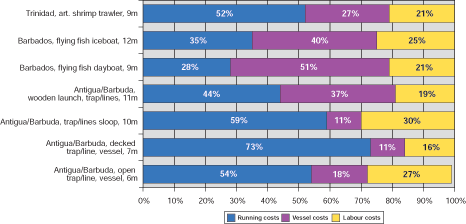
FIGURE 12
Total costs of small-scale fishing vessels in the Caribbean
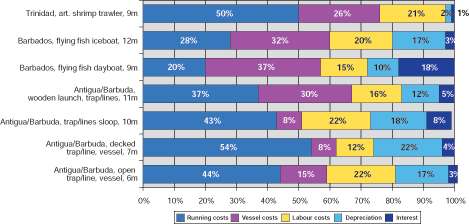
In case of the three traditional lobster boats in Antigua and Barbuda, labour costs are even the least important cost component, while in the case of larger lobster boats in Antigua and Barbuda and artisanal shrimp trawlers in Trinidad, labour costs are the second highest cost component, followed by vessel costs.
Taking into account the cost of depreciation and interest, the cost structure of small-scale fishing vessels in the Caribbean resembles more the situation found in Europe than the one in Senegal. The vessel costs combined with depreciation and interest range between 24% and 48%, which is close to the situation found in Europe and indicates only a slightly lower level of capital investment. In the case of the two types of boats catching flying fish in Barbados and the sloop catching lobsters and bottom fish in Antigua and Barbuda, vessel costs together with depreciation and interest even account for the highest share of total expenses.
Different from vessels in Europe though, running costs rank second and labour costs are the least important component, both of operating and total expenses.
When looking at the cost structure of small-scale fishing vessels in South and Southeast Asia, labour costs are the most important component of the costs of operation of four of the six types of vessels shown in figure 13 below. The situation is thus similar to small-scale fishing vessels in Europe and in Senegal. In the case of the Indian log raft operating trammel nets and of the Thai push netter, running costs exceed labour costs. As in the case of the most Caribbean and Senegalese vessels and different from European small-scale fishing vessels, running costs rank second and vessel costs rank third.
Considering the cost of depreciation and interest, figure 14 below shows that vessel costs together with the cost of depreciation and interest range between 15% and 46%, which is more similar to the situation found in the Caribbean and Europe than in Senegal.
FIGURE 13
Operating costs of small-scale fishing vessels in ASIA
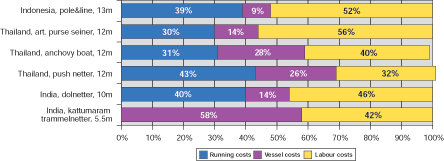
FIGURE 14
Total costs of small-scale fishing vessels in ASIA
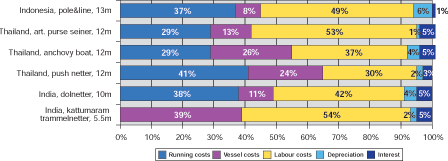
However, in no case do vessel costs combined with depreciation and interest account for the highest share of total expenses, as it has been the case with some categories of vessels in Europe and in the Caribbean.
In three of the six cases i.e. the Thai push netters and anchovy boats and the Indian kattumaram do vessel costs together with depreciation and interest rank second while in the other three cases they are the least important cost components. This again indicates a relatively low level of capital investment.
In this section, the cost structure of different types of tuna vessels is compared. Three fishing methods are used by the vessels, which have been covered by the study i.e. pole and line fishing (in Indonesia and Spain), longlining (in India and Indonesia) and purse seining (in Spain). As figure 15 below shows, each of the fishing method has a different cost structure.
FIGURE 15
Total costs of tuna vessels
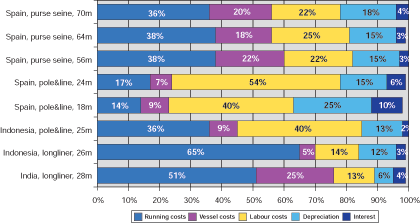
In the case of the Indian and Indonesian longline vessels covered by the study, running costs and particularly the cost of fuel are by far the most important cost component in longline fishing. As can be seen from the cost structure of the Indian and Indonesian longliners, running costs account for 51% and 65% respectively of the total costs, including the cost of depreciation and interest of these types of fishing vessels. In the case of the Indian and Indonesian longline vessels, running costs are even higher than vessel costs and the costs of depreciation and interest combined. The share of labour costs of the total costs of tuna longlining is very similar in India and Indonesia and labour costs only account for 13% and 14% respectively of the total costs.
As far as differences between the two countries are concerned it can be observed that while on the one hand, running costs are lower in India, vessel costs account for 25% of the total costs while they only account for 5% of the total cost in Indonesia. The cost of depreciation is also much higher in Indonesia and could be related to the higher replacement value of longline vessels in Indonesia as compared to India.
The three classes of Spanish tuna purse seine vessels included in the study show a rather similar cost structure with vessel costs accounting for between 36% and 38% of the total costs, labour costs between 22% and 25% and vessel costs between 18% and 22%. If the cost of depreciation and interest is added to the vessel costs, this cost component is slightly higher than the running costs of the purse seine vessels.
The three types of pole and line vessel included in the study i.e. two types of Spanish vessels and one type of Indonesian pole and line vessels show a very characteristic cost structure, which is dominated by labour costs. These account for between 40% and 54% of the total costs of pole and line fishing, while vessel costs only account for between 7% and 9%. When comparing the 25m Indonesian pole and line vessel with the similar size class Spanish vessel, it is noticeable that the Indonesian vessel has a significant lower share of labour cost and running costs account for a relatively higher share of total costs. These differences are primarily related to a lower level of crew remuneration in Indonesia as a developing country as compared to Spain.
The following chapter highlights trends and changes in fishing technology, practices and level of exploitation of fisheries resources, which occurred since the previous cost and earnings studies were carried out between 1995 and 1997. Furthermore, the chapter highlights important features of the marine fisheries of the countries included in the study.
Since the previous cost and earnings study was carried out in China during 1995-1997, important changes have taken place. At the time of the previous study, 87% of the total catch originated from the East China Sea. In 2000, when the recent study was carried out, only 37% of the total marine catch came from the East China Sea. Even though less important now, the East China Sea is still China's most important fishing area, especially the coastal waters of Jiangsu, Zhejiang, Fujian Province and of the City of Shangha´. Most fishing grounds are between 100 and 200 meters deep.
The South China Sea, which was hardly fished by the fleets from China previously, is now being intensively exploited. The South China Sea has become the second most important fishing area, which accounts for 23% of the total Chinese catch. This diversification of fishing effort from the East China Sea to the South China Sea has mainly been caused by over-fishing in the East China Sea and by corresponding restrictions of fishing effort. Other important fishing areas are the Yellow and Bohai Seas, which contribute 34% to the total marine fish production of China. 6% of the total catch comes from deep sea and distant waters.
The study in China focussed on the fishing fleets operating in the East China Sea. These include 12 633 steel fishing vessels, of which 890 have more than 600 HP. There are more than 80 000 smaller wooden fishing vessels, more than half of which have less than 15 HP. There are also 13 854 non-motorised fishing vessels fishing in the East China Sea. The size of the fishing fleet greatly increased over the last few years. Particularly the number of steel vessels of more than 600 HP increeased by 77% since 1997.
Regarding the type of fishing technology used in the East China Sea, it is observed that more than half of the catch is taken by trawling. Due to overfishing, however, the catch per unit of effort of trawlers fishing in the East China Sea is steadily declining. This is particular true for bottom pair trawling.
Set net fishing is also of great importance and accounts for 18% of the total catch. Its importance is declining though. At the time of the previous study, it still accounted for one fourth of the total catch. Likewise, the importance of purse seining, which accounted for about one fifth of the total catch at the time of the previous study, has been continuously declining since the mid-eighties and in 2000 only accounted for 5% of the total catch of the East China Sea.
While the importance of set net fishing and purse seining is declining, gillnet fishing is becoming more popular. A large range of gillnets are now being used for various species and accounts for 13% of the total catch. This fishing method became popular at the beginning of the eighties and compared to 1995, an increase of 80% in the number of gillnets is observed.
Since 1999, the Chinese Government has intensified efforts to control and limit the expansion of fishing capacity in order to protect fisheries resources. For this purpose, a "zero growth" policy for marine capture fisheries has been adopted, which includes the following management measures and regulations:
When compared to the previous study carried out in the Republic of Korea, the total number of Korean fishing vessels declined from 3357 to 3002. The main reason for the decline is the overexploitation of many fisheries resources and fleet overcapacity, which resulted in a lower profitability of fishing vessels. The types of vessels the numbers of which declined include offshore stow netters, large purse seiners, anchovy mid-water trawlers, large bottom and mid-water pair trawlers, large bottom and mid-water otterboard trawlers, Danish seiners and Eastern Sea bottom trawlers. An increase in the number of vessels can be observed, however, in the case of offshore squid jigging vessels. There has not been any major change in fishing grounds since the last study was carried out.
The fishing areas are:
Regarding species composition, the only major change compared to the previous study is that squid has overtaken mackerel as most important species in terms of volume of catch because of the increase of the number of squid jiggers and the decline of the number of other types of fishing vessels.
As far as plans for future development are concerned, there is little potential for development of new fishing areas, neither in coastal areas nor offshore. Almost all types of fishing gears, equipment and fishing vessels in use now have been operated in the Republic of Korea since the 1970s. Almost all existing resources are fully exploited.
The Korean Government, through the Law of the Fishery Industry, actively controls fishing effort. Recently, the Ministry has stopped issuing new fishing licences in order to conserve fisheries resources.
The Thai fishing fleet has expanded significantly over the past three decades. This expansion has meant more fishing vessels and of a greater size and catching capacity. The Thai fishing fleet includes many small boats, as 50% of the fishing vessels are less than 14m in length. This includes many small otterboard trawlers operating in coastal waters. Almost three quarters of the Thai fishing fleet are small trawlers. In terms of volume of catch, the fleet of small to medium size purse seiners is also very important
Because of fleet expansion, there is a large number of new fishing units of less than 5 years, in particular trawlers of 14 - 18 m in length used for pair trawling and also purse seiners of 18 - 25 m in length. Other small vessels were introduced for push netting in very shallow waters but this method has recently been banned on many fishing grounds.
Fishing grounds within Thailand's EEZ are located in the Gulf of Thailand and in the Andaman Sea. The cost and earnings study in Thailand was confined to fishing vessels operating in the Gulf of Thailand. The Thai EEZ in the Gulf of Thailand covers an area of approximately 252 000 km2. The Gulf is relatively shallow with a mean depth of 45 m. and a maximum depth of 80 m.
The fishermen land their catch at 11 fishing ports and landing sites, 8 in the Gulf of Thailand and 3 in the Andaman Sea, which are administered by the Fish Marketing Organisation (FMO), and at 657 private landings sites scattered along the coast, 362 in the Gulf of Thailand and 295 in the Andaman Sea. The main species landed, in terms of volume, are sardine and anchovy. All pelagic fish species together account for 37% of the total catch. So called "trashfish" accounts for a share as high as 37%. Over the last ten years, the proportion of pelagic fish of the total catch has greatly increased. The catch of sardines and anchovy has almost doubled. The quantities of so called "trashfish" though have continuously declined, which indicates that fish which was previously used for fish meal or as animal feed is now being used for direct human consumption.
As far as fisheries legislation is concerned, there are three sets of laws, which regulate aquatic resource management and development of marine fisheries in Thailand: the Fisheries Act of B.E 2490 (1947), the Thai Vessel Act of B.E 2481 (1938) and the Law on Navigation in Thai Waters of B.E 2456 (1913). Of these laws, the Fisheries Act of B.E 2490 is most directly concerned with aquatic and fisheries resource management and regulates:
While it is generally accepted that fisheries resources in coastal waters have been fully or overexploited and fishing fleets and effort in the Gulf of Thailand needs to be reduced, new fisheries resources in offshore waters both in the Gulf of Thailand and the Andaman Sea have recently been identified. For the exploitation of most of these resources, agreements with neighbouring countries and the establishment of joint ventures are necessary. This also applies to the development of tuna fishing in the Indian Ocean to support the canning industries, which require substancial quantities of raw materials for processing.
When compared to the previous cost and earnings study carried out in India, the number of fishing vessels has increased further in all categories of vessels. Most fishing is carried out within the 100 m depth zone. In inshore waters, up to 30 m depth, traditional boats, both non-motorised and motorised, mainly powered by outboard engines, operate. These boats include traditional wooden displacement craft, log rafts locally called kattumarams as well as FRP boats. Over a period of five years, the number of traditional non-motorised boats increased from 146 285 to 159 481 and the number of motorised boats from 25 467 to 31 826.
Further offshore but sometimes on the same fishing grounds, mechanised vessel operate. These include many gill-netters, in certain areas purse seiners and almost everywhere small or medium size trawlers. The number of these mechanised boats increased from 34 848 to 46 918. There are both shrimp and shrimp-cum-fish trawlers but also shrimp trawlers catch and keep large quantities of fish. Medium size shrimp trawlers operate further offshore on the North East Coast with Visakhapatnam as their base. They also catch and keep high priced fish.
Traditional boats land their catches at larger fishing villages, which are connected to major roads. Mechanised fishing boats land their catch in ports and fish landing centres. Deep-sea fishing is mostly confined to the North East Coast with the base at Visakhapatnam. Purse seiners operate mainly off the West and South West Coast.
In 1997/98, 2.95 million tons of fish were landed. Prawns were the single most important species accounting for 15% of the total catch. 70 percent of fish catches were landed by mechanised vessels and 30 percent by non-mechanised ones.
Regarding the level of exploitation of marine fisheries resources, it is assumed that in inshore waters, most of the commercially important fish species are overexploited. This includes Bombay duck, mackerel and oil sardine. Other commercially important species such as seer fish, crabs and lobsters have reached maximum levels of exploitation. It is assumed, however, that anchovies, some other clupeids, tunas, bill fishes, perches, pomfrets and sciaenids could still tolerate a higher fishing effort, especially beyond the 50 m depth zone, and that about 700 multi-purpose so called new generation fishing vessels of about 18 m length could be introduced for that purpose.
Under the National Marine Fishing Regulation Act, fisheries legislation and regulation are the responsibility of State Governments. As a result, fisheries regulations differ from place to place. The operation of foreign fishing vessels in India's EEZ is regulated under the provisions of the Maritime Zones of India Act of 1981.
From 1991 onwards, a policy was introduced, which promoted the leasing of foreign fishing vessels for operation in the Indian EEZ, joint ventures between Indian and foreign companies in deep sea fishing, fish export and processing and test fishing through engagement of foreign fishing vessels. As a result, the number of foreign fishing vessels exploiting the Indian EEZ under various arrangements increased considerably. Eventually, this led to conflicts with traditional fishermen.
Partly as a consequence of these conflicts and with a view to formulate a policy for a sustainable use of marine fisheries resources, the so-called Murari Committee was established in 1995. With a view to conserve fisheries resources and to protect traditional fishermen, the committee recommended the cancellation of fishing permits of joint ventures, charters and lease arrangements as well as not to renew or grant new licenses to foreign vessels for fishing in India's EEZ. The committee also recommended modernisation of traditional fishing vessels and introduction of medium size multi-purpose fishing vessels.
Other important recommendations concerned the development of a high sea fishery through a new deep sea fishing policy; the strengthening of surveillance and control of fishing zone restrictions as well as assistance to traditional fishermen through training and upgrading of equipment.
The most important recommendations, which were incorporated in the Ninth Five-Year Development Plan, include:
Over the last decade, marine fisheries in Indonesia expanded considerably. The number of fishermen in Indonesia increased from 1.4 million in 1988 to
2.1 million in 1997, which is equivalent to an average annual increase 4.5%. Half of the fishermen are full-time fishermen. Over the period from 1989 to 1998, marine capture fisheries output increased at an average rate of 5.6% per year. 40% of marine fisheries production consists of small pelagics and 20% of large pelagic fish. The major fish species landed were scads
(128 459 tons), Indian mackerels (204 763 tons), eastern little tuna (236 673 tons), fringe-scale sardinella (174 691 tons), skipjack (227 068 tons), anchovies (166 808 tons), trevallies (128 459 tons) and Indian oil sardinella (153 965 tons).
In 1997, the total number of marine fishing boats operating in Indonesia was about 402 000. The small-scale fleet consists of non-powered boats and boats equipped with outboard and inboard engines of less than 5 GT. It accounted for 94% of the total number of fishing boats in 1997. In 1997, about half of the total marine catch was caught by purse seines. Other important fishing gears are surrounding or ring nets without purse line (lampara net/payang), drift and set gillnets and pole and line used to catch skipjack. The cost and earnings study in Indonesia covered purse seiners, skipjack pole and liners, tuna longliners and gillnetters.
The Indonesian purse seiners included in the study were originally ring netters operating with FADs locally called rumpon (lure). Most of them, i.e. 3084 units in 1998, have their fishing bases on the northern coast of Java. They target small pelagic fish, such as scads, mackerels, sardinella, trevallies, Spanish mackerel, anchovies and also small tunas and hairtails. Replacement of the traditional payang and lampara nets through purse seines, motorization of boats and extension of duration of fishing trips made it possible to catch more fish.
In 1998, 1515 skipjack pole and liners were operating in Indonesia. Most of them motorised fishing boats of 10 GT and 30 GT, used with fish aggregating devices. 60% of the vessels operate in Maluku and east of Indonesia/ Irian Jaya.
The tuna longliners covered by the study use hundreds of baskets of 5 - 11 hooks being attached to the mainline by 30 m long branchlines, attached to the mainline every 50 - 60 meters. Baits used are scads, mackerels, milkfish and similar species. Smaller longliners normally use monofilament lines. In 1998, 2285 vessels were operated, many of them by fishing companies based in Bali. The longliners mainly fish in the Banda Sea, the Sulawesi Sea and in the Indonesian Exclusive Economic Zone of the Indian Ocean and Pacific Ocean. Fish caught by tuna longliners are mainly yellowfin, big-eye and bluefin tunas and albacore, as well as other large pelagic species such as billfish.
The gillnetters covered by the study are 30 GT boats operating 30 to 60 pieces of driftnets with 10 cm meshsize and 8 meters height. These boats are operated from North Java to catch Spanish mackerel as target species and also Indo-pacific mackerel, little tunas, pomfret, etc.
Most fishing grounds in the western part of Indonesia are fully exploited because of their proximity to major markets and infrastructure located in nearby Java and Sumatra. Fishing grounds in the eastern part of Indonesia are still underexploited except for demersal fish and shrimp in the Arafura Sea. According to the National Commission on Stock Assessment of Marine Fisheries Resources, the resources of demersal and coral fishes are almost fully exploited in many areas, shrimps are already overexploited while there is a rather large potential for large pelagic and some potential for small pelagic species in certain areas.
Indonesia is divided into nine fisheries management zones. In each of the zones there is a co-ordinating forum for the management and utilisation of fisheries resources dealing with the allocation of fishing effort, the issue of fishing licenses and with the evaluation of management measures and controls.
In 1997, the industrial fishing fleet of Senegal consisted of 281 vessels. Most of the larger vessels are rather old. The average age of ice vessels is 24 years and that of freezer vessels is 21 years. One third of the industrial fleet operates under foreign flags. Almost three quarters of the tuna vessels fly European Union flags. 78% of the industrial vessels are trawlers and exploit demersal resources; the other vessels target tuna.
The artisanal fishing fleet consists of 7 616 canoes with 44 257 fishermen. Compared to the previous study carried out in Senegal, the number of artisanal fishing boats has further increased. 91% of the units are motorised. The main fishing methods are purse seining, encircling gillnetting, handlining and the operation of fixed gillnets, handlines and pots.
Regarding fisheries regulations, pelagic fishing vessels can fish nearer to the coast than vessels exploiting demersal resources. The fishing zone demarcation reflects the configuration of the continental shelf, which is narrow to the North of Cap Verde (Dakar) and larger in the south. For industrial fishing vessels, fishing area restrictions and reserved areas depend on a combination of the tonnage of the vessels, the fishing method, which is used, on whether the boats preserve their catch in ice or freeze it and finally on the type of resources, which are being exploited i.e. demersal or pelagic resources. For artisanal fishing vessels, regulations depend on the fishing method, which is being used.
Since 1987, a law restricts fishing power. Vessels larger than 1500 GT are not allowed. The law also regulates fishing gear essentially through meshsize regulations, the issuance of fishing licences and minimum sizes for fish, which can be caught. In 1998, a new law introduced a "Code for Marine Fisheries". Main changes concern access to fishing grounds and involvement of fishing communities in fisheries management. Industrial vessels have to pay for fishing licences and the construction of artisanal canoes is now controlled and subject to official permit and registration. Multi-annual fisheries management programmes are being prepared and implemented as well as fisheries monitoring plans to ensure the sustainability of marine fisheries in Senegal.
Government plans for future fisheries development focus on offshore fishing, on the replacement of old industrial fishing vessels, on the development of tuna fishing, particularly longlining and on the exploitation of deep sea demersal resources, especially hake. As far as inshore fishing operations are concerned, the emphasis is on moving pelagic fishing activities further offshore, on reducing fishing effort on demersal resources and on improved control and monitoring.
In the Norwegian fishing fleet, 50% of the fishing vessels are less than 8m long and more than a third are open vessels. Since 1970, the number of decked vessels stayed quite stable around 8.500. The average age of Norwegian fishing vessels is rather high, especially the age of very small vessels. Only a small part of the vessels i.e.18% are used throughout the year. Strict regulations are in place to limit the total catch to a level, which is considered a reasonable level for sustainable fisheries.
Three main fishing areas are distinguished:
Barents Sea. Demersal fish such as cod, saithe, haddock are exploited by large fresh fish and factory trawlers Shrimp are caught by large specialised freezer trawlers of which 24 units are more than 50 m long. Pelagic fish such as capelin and herring are caught by purse-seiners and pelagic trawlers. In 2000, there were 37 large purse seiners with 1,000 GT and more capacity of which, however, not all are permanently fishing in the Barents Sea.
Norwegian Sea and coastal areas. Demersal fish such as cod, saithe and other demersal species are exploited by a coastal fleet of 575 vessels, 13 m long and above, using traditional gears such as gillnets, longlines, handlines and Danish seines and operate throughout the year. Saithe is also exploited by small purse seiners in a seasonal fishery. Non TAC-restricted species such as ling, blue ling and tusk are exploited by longliners operating offshore. There is also exploitation of shrimp by small fresh fish trawlers of between 20 to 30 m length. Pelagic resources are seasonally exploited such as spawning herring by purse-seiners and pelagic trawlers in spring.
North Sea and Skagerrak. The main fisheries are for pelagic fish such as herring, mackerel and sprat caught by purse seiners and for species that are caught by bottom trawlers for reduction to fish meal and fish oil. These include Norway pout, blue whiting, and sandeel. Shrimp is also caught by specialised shrimp trawlers.
While most catches are taken inside the Norwegian EEZ, 80% of stocks are shared with neighbouring countries such Russia, Iceland, Faeroe Islands and the European Union. Pelagic species account for more than three quarters of the volume of the total catch but only for one third of its value. Shrimp constitutes only 2.4% of the volume of the total catch but 10% of its value.
In 1998, the German fishing fleet consisted of 2305 vessels with a capacity of 67 697 GT in tonnage and 159 737 kW in engine power. The German fishing fleet can be divided into three main fleet segments i.e. the coastal fishery, the cutter deep-sea fishery and the large-scale trawler deep-sea fishery. 1 803 vessels are involved in coastal fishing in the Baltic and North Sea for groundfish, herring and flatfish. 1 777 of these boats are less than 12 m in length. 446 vessels between 15 and 32 m of length and 40 to 200 GT capacity, most of them beam trawlers, are involved in the cutter deep-sea fishery. These vessels operate in North Sea and Baltic Sea and target shrimp, flatfish and groundfish. The large-scale trawler deep-sea fleet segment consists of
4 pelagic and 8 bottom trawlers fishing in third countries, EU-, NAFO- and NEAFAC waters. The pelagic trawlers have a capacity of 4 566 GT and 2 937 kW while the bottom trawlers have a capacity of 2 180 GT and 2 602 kW.
The German fishing vessels are rather old. 80% of the coastal vessels of more than 12 m length are more than 25 years old. 60% of the cutter trawlers are more than 25 years old.
The North Sea is the main fishing area for German vessels and accounts for 61% of the total catch. Over the last few years, fishing operations have increased in the North Sea, off Greenland and in the Southeast Atlantic. At the same time, fishing effort was reduced elsewhere. In terms of quantity, small pelagics, in particular herring and horse mackerel, are the most important species caught. 71% of the catch of the offshore fleet consists of small pelagics.
Regarding landing areas, about 20% of the catch of the coastal and cutter fleets is landed abroad, mainly in Denmark and Holland while the deep sea fleet lands 86% of its catch outside of Germany.
The fish stocks, which are exploited by the German fleet in North European waters, are managed within the framework of the European Common Fisheries Policy (CFP) and International Conventions. In Germany, national quotas are broken down by Government regulations by vessel type and species. Specific quotas are allocated through the "Deutscher Fischerei Verband". Some are allocated on a "first come first served" basis. Others are directly allocated to deep-sea vessels. Only when fishing opportunities are scarce are quotas shared through Producers Organisations (PO).
According to the EU Multi-annual Guidance Programme (MAGP) for the reduction of fleet capacity, gross tonnage was to be reduced in Germany by 16% and engine power by 5% over the period 1.1.97 to 31.12.01. These targets were already achieved by 1.1.98. As the German fishing fleet is rather old, it is felt that there is a need to build new vessels and modernise others in order to have a competitive fleet without increasing fishing effort. In addition to EU policy and regulations, there are national regulations, which include both federal regulations and "Laender" regulations.
With regard to the level of exploitation of fish stocks targeted by German fishing fleets, stocks of North Sea and Atlanto-scanian herring are considered in a good condition. The same applies to stocks of tuna, North Atlantic redfishes, saithe and mackerel. For North Sea cod, a good chance of recovery is predicted. The stocks of Alaska pollack, cod and halibut in different areas of the North Atlantic, cod in the Baltic, all stocks of hake, and plaice in the North Sea are declining, however.
70% of the French fishing vessels i.e. 4 198 units operate off the Northern and Western coasts of the country and the rest i.e. 1776 vessels in the Mediterranean Sea. Vessels fishing in the Mediterranean Sea are smaller vessels most of them less than 12 m long. All vessels larger than 40 m are operating off the Northern and Western coasts of France.
Since 1983, the French fishing fleets operating from the Northern and Western coasts have been continuously reduced according to the EU Multi-annual Guidance Programmes to adapt fleet capacity and fishing effort to sustainable levels of exploitation of fisheries resources. Since 1990, the number of fishing vessels has been reduced by 31%. Over the last 3-4 years only, the number of fishing boats was reduced by 14% while vessel capacity in terms of engine power was reduced over the same period by 8%.
Regarding the age structure of the French fishing fleet it can be observed that the average age of French fishing vessels has been increasing over the years. The proportion of vessels older than 15 years for example increased from 54% in 1995 to 64% in 1999. According to the European Multi-annual Guidance Programmes (MAGP), no authorisation can be given to build new boats as long as targets are not reached except for the replacement of old units and at the rate of withdrawal of 130 kW for introduction of 100 kW. There seems to be a need for replacement of fishing units over the next decade and the fishing industry is now replacing old boats by fewer but more efficient new units.
30% of fish landed in France is caught in French waters of the European EEZ i.e. in the English Channel, the Atlantic Ocean and in the Mediterranean Sea. Small-scale fishing accounts for 80% of these landings. 50% of fish landed in France is caught in other parts of the European EEZ i.e. West Cornwall, East and West Ireland and Western Scotland. Semi-industrial and industrial fishing accounts for 80 percent of these landings. The rest of fish landings comes from international waters or from third countries' EEZ and is caught under bi-lateral agreements involving industrial fishing vessels especially tuna seiners.
Over the last few years, all categories of vessels of less than 20 m length have increased their catch efficiency by 10 to 20%. Regarding the main species caught, fish accounted for 55% of the total catch and small pelagics accounted for almost 40% of the total fish catch.
As in the case of other EU countries, the Common European Fishery Policy applies to French fisheries.
This includes:
The potential for future development of the French fleet focusses on gaining access to new fishing areas through bi-lateral agreements with third countries, exploitation of so far under-exploited deep-sea resources and the replacement of old fishing units through more efficient new units.
In Spain, fishing is a particularly important economic and social activity. In 1997, more than 18.000 fishing boats were registered, which employed 68.000 fishermen. In 1998, the fleet of trawlers, almost entirely bottom trawlers, numbered 2 569 units. Large Spanish freezer trawlers are operating in all parts of the Atlantic Ocean. There are more than thousand fishing boats, using surrounding nets for small pelagic fish species. In addition, there are more than 5 000 gill-netters, almost 2 000 handliners, 1 500 longliners and more than 800 pole and line vessels as well as a fleet of purse seiners.
As far as the age structure of the Spanish fishing fleet is concerned, the proportion of old vessels is very high. 64% of the Spanish fishing fleet is more than 20 years old. According to vessels categories, 63% of the semi-industrial trawlers are more than 20 years old and 43% of the pole and liners. However, over the last 5 years, a number of new vessels were introduced, particularly semi-industrial trawlers, industrial trawlers and pole and line vessels.
The third and fourth EU Multi-annual Guidance Programmes for the period 1992 to 1999 required from Spain the withdrawal of up to 900 vessels of 119 000 GT and 238 000 kW. Spain fulfilled her requirement. Between 1996 and 1998 alone, the number of Spanish fishing vessels decreased by about 6% and the total engine power by almost 20%. This reduction was mainly achieved through a reduction in the number of trawlers by almost 30%. As Spain has fulfilled her commitments under the MAGP, the country is now going ahead with a fleet modernisation and renewal programme.
The future development of Spanish marine fisheries is seen as depending on the access to new fishing areas through fishing agreements with Canada, South American countries such as Argentina, North African countries such as Morocco and Mauritania as well as with other countries in Africa and countries bordering the Indian Ocean. Other opportunities are seen in the exploitation of new resources including fisheries resources in remote areas of the Northwest Atlantic, the Northeast Atlantic, the Southwest Atlantic, in deep waters off Angola, in the Southeast Atlantic, the Southwest Indian Ocean and in Antarctic waters.
In 1998, the trawler fleet of Trinidad & Tobago covered by the study consisted of 19 so-called industrial vessels, 10 semi-industrial trawlers and 84 artisanal trawlers. Artisanal and semi-industrial trawlers make day trips and tow a single trawl net while industrial trawlers are outrigger trawlers, which stay at sea for about two weeks and operate two trawl nets. Semi-industrial trawlers are 9-12 m long and have 120-180 hp engines. Industrial trawlers are 11-23 m long and have 270 to 310 hp engines. The trawler fleet of Trinidad & Tobago is relatively old. 83% of the semi-industrial units are 15 to 20 years old and 84% of the industrial trawlers are more than 20 years old.
The main landings of trawlers in Trinidad & Tobago consist of shrimp and by-catch, which can be double in volume as the actual shrimp catch. The main fishing area for all vessels is the Gulf of Paria. The industrial units also fish off the North Coast and in the Columbus channel. Regulations concerning mesh size, dimensions, minimum sizes of fish, prohibited areas, species, fishing seasons are only applied within the 12 n mi territorial sea. Since 1997, there is a fishing agreement with Venezuela but there are problems with its implementation.
As far as the state of the resource is concerned, shrimp has been overfished in the early nineties and the catch per unit of effort declined. Government policy is to limit the fishing effort on shrimp to the 1996 level or below this level. There is no potential for the development of new fishing areas. As a consequence, there are no plans for the expansion or modernisation of the trawler fleet other than the option to diversify trawlers to other fishing methods.
In 1998, more than half of Argentinean fishing fleet consisted of trawlers, 368 vessels altogether. About one third of the trawlers were more than 36 m long and 26% between 24 and 36 m long. The second most common types of vessel are gill-netters, 15% of the total, and a third of these are large units, between 36 and 45 m long. In addition, there is a fleet of small purse seiners, less than 18 m long, and a few large longliners of 45 to 60 m in length.
The Argentinean fishing vessels are rather old: More than 40% of the vessels are more than 25 years old. The deep-sea fleet of larger vessels of more than 30 m in length is of more recent construction and only 25% of the vessels are more than 25 years old. In the so-called artisanal fishing fleet with vessels of about 20 m length, 70% of the vessels are more than 25 year old.
The total marine catch of Argentinean fishing vessels is about 1 million tons, of which one third consists of squid, 31% of Argentinean hake and 12% of Patagonian whiphake. After reaching peaks in 1997, landings of most fish species declined. This is particularly true for the two main species i.e. Argentinean hake and squid.
Regarding Argentinean hake, the main target species of trawlers, after reaching a maximum in 1996, the landings dropped by almost half indicating heavy overexploitation of the resource. Strict measures were taken by the Argentinean Government, including the measure taken in June 1999 to ban Argentinean hake fishing by freezer trawlers north of 48░S. Trawlers now target new species and areas, especially squid and Patagonian whiphake, the latter one to substitute Argentinean hake. Compared to 1996, landings of Patagonian whiphake increased tenfold. In accordance with above changes, fishing operations are moving southwards.
In accordance with national fisheries regulations, within the Argentinean EEZ, which extend up to 200 n mi from the shoreline, only vessels with Argentine flags and holding a licence obtained for a maximum of three years are allowed to fish. Since 1992, however, a decree allows the chartering of foreign flag vessels for periods of three years. Argentina and the European Union have signed a fishing agreement for an annual catch up to 250 000 tons during an initial five-year period. Provinces in Argentina have authority to regulate fishing operations in in-shore fisheries up to 3 n mi from shore.
Peru is one of the major fishing producing countries in the world in terms of volume of catch. In 1999, the total catch was 8.2 million tons. The resources fished, particularly the pelagic ones, are dependent on important hydro-biological factors including the Humbolt and El Ni˝o currents, which is why catches are fluctuating. For example in 1998, only 4.3 million tons were caught. Fluctuations occur especially in the case of small pelagics. In 1998, the landings of small pelagics accounted for 70% of the total landings. Among small pelagic species, anchovies and sardines contribute almost half to the total small pelagic catch but also mackerel and horse mackerel are important species.
The Peruvian fishing fleet is rather old, except for purse seiners fishing for canneries. More than half of these vessels are less than 3 years old.
Fisheries legislation and regulations rule that industrial and semi-industrial vessels have to operate beyond the 5 n mi limit from shore. Minimum sizes for fish being landed are determined as 12 cm for anchovies and 35 cm for hake. Meshsize regulations stipulate a minimum of 13 mm for the bunt of anchovy purse seines and 110 mm for the meshes of codend used for hake fishing. Quotas are fixed every year for small pelagic species and there are closed periods i.e. 173 days in 1998 for both trawlers and purse-seiners. No increase of fishing effort by purse seiners and trawlers is allowed which is why old vessels can only be replaced by new units with exact equal capacity. In hake fisheries, purse seiners and very large trawlers are prohibited.
11 See FAO Report on the State of World Fisheries and Aquaculture 2000, FAO Rome 2000, pp 93/94.
12 Labour costs include wages and other labour charges such as insurance and employers` contributions to pension funds. Running costs include fuel, lubricants, the cost of selling fish, harbour dues, the cost of bait, salt, ice, packing materials and of food and supplies for the crew. Vessel costs include vessel and gear repair and maintenance expenses and vessel insurance.
13 See also ANNEX I.
14 The stow net is actually not a trawl net but a fixed bagnet, a passive gear, even though its shape and design is similar to that of a trawl net.